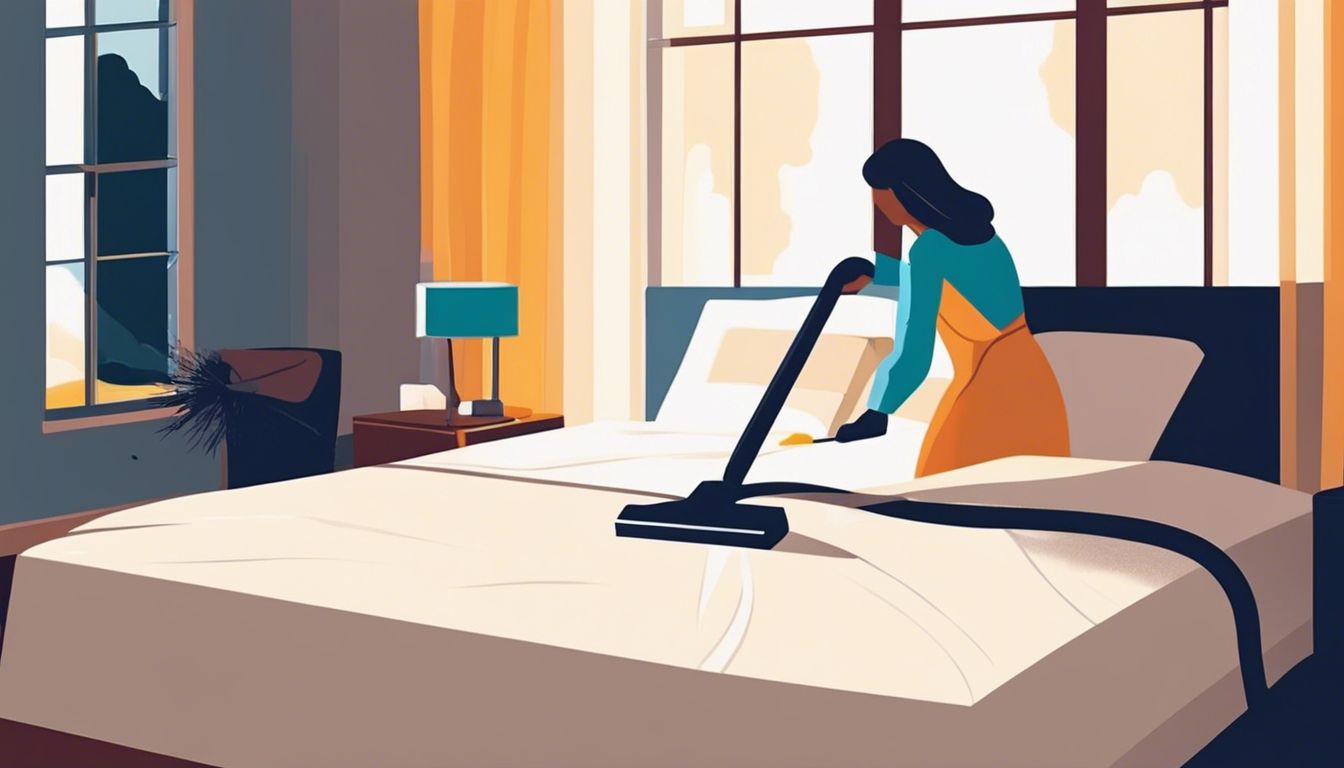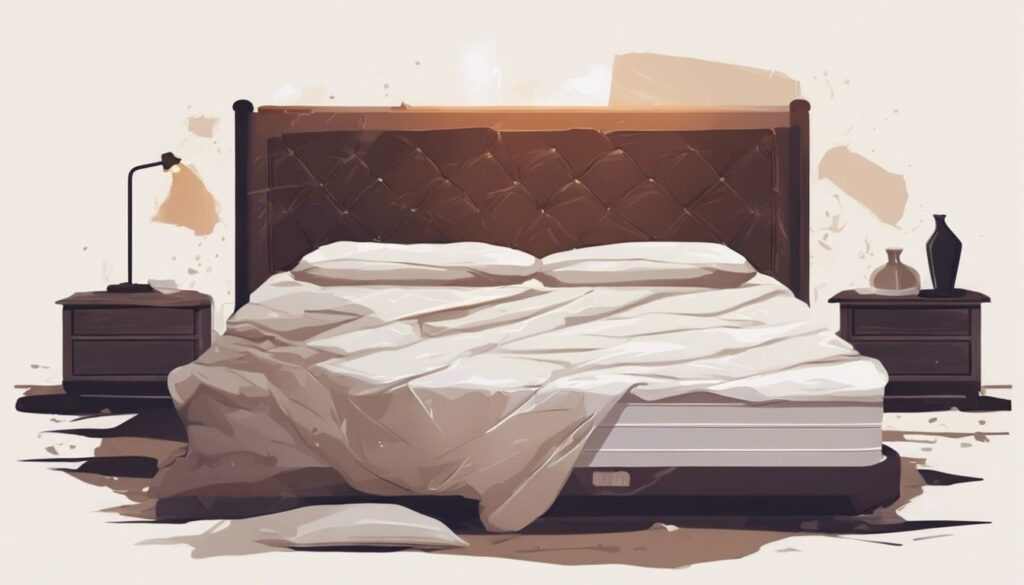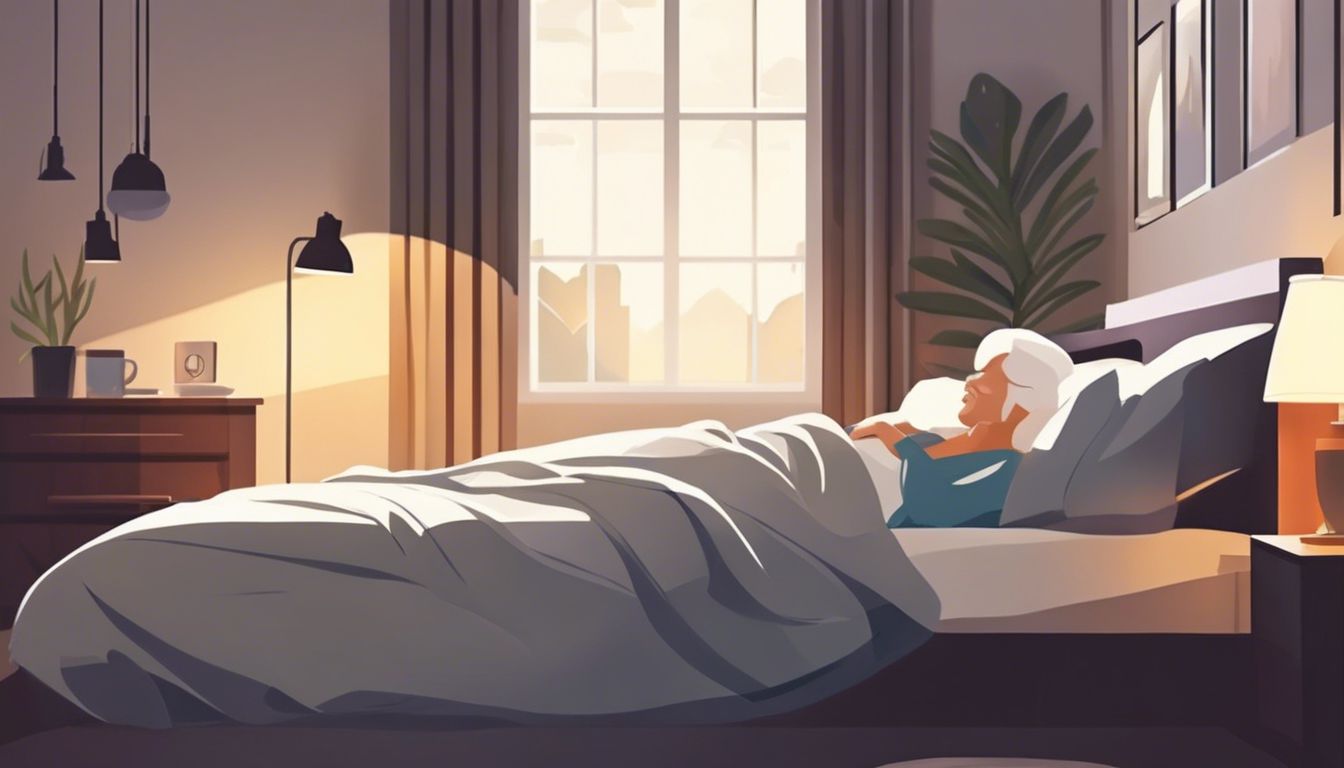Is your mattress showing signs of wear and tear, affecting your sleep quality? A well-maintained mattress can last up to 10 years, providing comfort and support night after night. This guide will walk you through simple steps to extend your mattress’s life and keep it in top shape.
Ready for better sleep?
📋✅
- Use a mattress protector to shield against spills, stains, dust, and allergens, and wash bed linens every 1-2 weeks in hot water to keep your mattress clean.
- Ensure proper support with a sturdy bed frame and box spring, and check them every 6-12 months for signs of wear or damage.
- Vacuum your mattress every 2-3 months using an upholstery attachment, and use allergen-proof covers to protect against dust mites and other irritants.
- Rotate your mattress every 6-12 months to prevent sagging, and promptly clean spills with a gentle solution of baking soda, salt, and water.
- A well-maintained mattress can last up to 10 years, providing better sleep quality and supporting memory consolidation, especially important for seniors.
Routine Mattress Maintenance

Keeping your mattress clean and protected is key to its longevity. Regular upkeep helps prevent wear and extends the life of your sleep surface.
Using a mattress protector
A mattress protector is a vital accessory for maintaining your bed’s longevity and cleanliness. This thin, removable cover acts as a barrier against spills, stains, dust, and allergens.
High-quality protectors offer waterproof protection while still allowing air to circulate, preventing moisture buildup and mold growth.
Regular use of a mattress protector can significantly extend the life of your mattress. It’s easier to clean than the mattress itself – simply toss it in the washing machine as per the manufacturer’s instructions.
This simple step can keep your sleeping surface hygienic and free from irritants that may affect sleep quality.
A clean bed is the foundation of a good night’s sleep.
Regularly washing bed linens
Bed linens need frequent cleaning to keep your mattress fresh and hygienic. Sheets, pillowcases, and blankets trap sweat, skin cells, and oils from our bodies. These substances can seep into the mattress if left unchecked.
Experts recommend washing bedclothes every 1-2 weeks in hot water to kill dust mites and remove allergens. This simple habit prevents the buildup of irritants that may trigger allergic reactions or respiratory issues.
For caregivers, maintaining clean bed linens is crucial for the health and comfort of those in their care. Moisture-wicking fabrics can help manage nighttime sweating in seniors or bedridden individuals.
Hypoallergenic covers provide an extra barrier against allergens for those with sensitivities. Regular washing of these items not only promotes better sleep but also reduces the risk of skin irritations and infections.
It’s a small task that makes a big difference in overall well-being and mattress longevity.
Ensuring Adequate Mattress Support
A sturdy foundation is crucial for your mattress’s health. The right frame and box spring prevent sagging and extend your mattress’s life.
Using proper frame and box spring
A solid foundation is crucial for your mattress’s longevity and comfort. Your bed frame should provide ample support, with center bars for queen and king-sized mattresses. Box springs offer additional stability, distributing weight evenly across the mattress surface.
This combination helps prevent sagging and maintains proper spinal alignment during sleep.
For platform beds, wide slats may require extra reinforcement to adequately support your mattress. Regular inspection of both frame and box spring is essential – look for signs of wear, such as cracks or warping.
Replacing damaged components promptly can extend your mattress’s life and ensure a restful night’s sleep. Proper support not only enhances comfort but also helps manage allergens by keeping your mattress elevated off the floor.
Checking and replacing support when necessary
Building on the importance of a proper frame and box spring, regular inspections of your mattress support system are crucial. Caregivers should examine the foundation every 6-12 months for signs of wear or damage.
Look for cracks, warping, or sagging in wooden slats or metal springs. These issues can lead to premature mattress sagging and discomfort for seniors.
If problems are found, prompt replacement is key. Follow the mattress maker’s guidelines for support replacement to maintain warranty coverage. New box springs or platform beds can breathe new life into an aging mattress, improving sleep quality and comfort.
For memory foam or latex mattresses, solid platforms often work best. Innerspring models typically need box spring support. Regular checks and timely replacements help extend mattress life and ensure a restful sleep environment for seniors.
Managing Allergens and Dust Mites
Allergens and dust mites can turn your mattress into a breeding ground for irritants. Regular cleaning and proper protection are key to keeping these unwanted guests at bay.
Vacuuming the mattress regularly
Regular vacuuming is crucial for maintaining a clean and hygienic mattress. This simple practice helps remove dust, dead skin cells, and other allergens that accumulate over time.
- Use a vacuum cleaner with an upholstery attachment for best results
- Vacuum the entire surface of the mattress, including sides and corners
- Pay extra attention to seams and tufts where debris can collect
- For foam mattresses, use a low suction setting to avoid damage
- Aim to vacuum your mattress every 2-3 months
- Consider using baking soda before vacuuming to absorb odors
- Remove and wash mattress covers separately
- Vacuum box springs and bed frames while you’re at it
- Use a HEPA filter vacuum if you have allergies or asthma
- Don’t forget to vacuum under the bed to prevent dust buildup
Using allergen-proof mattress covers can further protect against dust mites and other irritants.
Using allergen-proof mattress covers
Allergen-proof mattress covers offer a powerful defense against dust mites, pollen, and other irritants. These specialized barriers encase the entire mattress, creating a shield between sleepers and potential allergens.
For caregivers, this simple addition can significantly improve air quality and reduce allergy symptoms for those in their care.
Investing in high-quality, hypoallergenic covers is crucial for maintaining a clean sleep environment. These protective layers not only block allergens but also guard against spills, stains, and wear.
Caregivers should look for covers made from breathable materials that won’t compromise comfort while providing robust protection for the mattress beneath.
Addressing Wear and Tear
Mattresses face constant pressure and use. Regular care helps prevent damage and extends their life.
Rotating and flipping the mattress periodically
Mattress rotation helps distribute wear evenly, extending its lifespan and comfort. This simple practice can significantly impact sleep quality and mattress longevity.
- Rotate your mattress every 6-12 months to prevent sagging and indentations
- For innerspring and hybrid mattresses, flip them over in addition to rotating
- Memory foam mattresses generally don’t need flipping, only rotation
- Mark your calendar or set a phone reminder for regular mattress maintenance
- Use the changing of seasons as a cue to rotate your mattress
- Enlist help when rotating or flipping heavier mattresses to avoid injury
- Vacuum the mattress surface and underneath before rotating
- Check for signs of wear or damage during rotation and address issues promptly
- Consider using mattress handles, if available, for easier maneuvering
- Rotate box springs as well, if your bed setup includes them
Managing stains and spills promptly
Stains and spills can significantly impact the lifespan and hygiene of your mattress. Quick action is crucial to prevent permanent damage and maintain a clean sleeping environment.
- Use a clean, dry cloth to blot the spill immediately. Avoid rubbing, which can spread the stain and push it deeper into the mattress fibers.
- Create a cleaning solution with baking soda, salt, and water. This gentle mix is effective for most stains without harsh chemicals that could harm the mattress material.
- Apply the solution sparingly to the affected area. Use a clean, damp cloth to gently dab the stain, working from the outside in to prevent spreading.
- For stubborn stains, consider a specialized mattress cleaner. Always test on a small, inconspicuous area first to ensure it doesn’t damage the fabric.
- After cleaning, use a fan or dehumidifier to dry the area thoroughly. Moisture left in the mattress can lead to mold and mildew growth.
- Once dry, sprinkle baking soda over the entire mattress surface. Let it sit for several hours to absorb any remaining odors before vacuuming it off.
- For biological stains, an enzyme cleaner may be more effective. These cleaners break down proteins in bodily fluids, helping to remove both the stain and odor.
- Consider using a mattress protector to prevent future stains. Water-resistant options can safeguard against spills while still allowing the mattress to breathe.
The Link Between Sleep, Memory, and Mattress Quality in Seniors
Sleep plays a crucial role in memory consolidation for seniors. A high-quality mattress can significantly improve sleep quality, leading to better cognitive function and memory retention.
Proper support from innerspring mattresses or memory foam options helps reduce sleep disturbances, allowing for deeper, more restorative rest. This uninterrupted sleep is essential for the brain to process and store information from the day.
Mattress care becomes even more important as we age. Regular maintenance, such as using mattress protectors and addressing premature sagging, can extend a mattress’s lifespan and maintain its supportive properties.
For seniors with seasonal allergies or respiratory issues, hypoallergenic mattress pads and frequent vacuuming can create a healthier sleep environment. These practices not only improve comfort but also contribute to better overall health and cognitive function in older adults.
Proper mattress care extends its life and enhances your sleep quality. Regular cleaning, rotation, and protection ward off allergens and wear. A well-maintained mattress supports your body, promoting better rest and overall health.
Remember – your mattress is an investment in your well-being. With these simple steps, you’ll enjoy comfortable, restorative sleep for years to come.
For a deeper understanding of how your mattress affects sleep quality and memory, especially in seniors, visit our comprehensive article here.
FAQs
1. How often should I clean my mattress?
Clean your mattress every 3-6 months. Use mild detergent for spot cleaning. Vacuum it to remove dust and allergens. This helps extend your mattress lifespan and keeps it comfy.
2. Can mattress toppers help protect my mattress?
Yes, mattress toppers can shield your mattress from wear and tear. They add an extra layer of comfort too. Choose one that fits your sleep needs – memory foam, latex, or down alternatives work well.
3. How do I prevent bed bugs from infesting my mattress?
To avoid bedbugs, wash your bed sheets and comforters regularly in hot water. Use protective covers on your mattress and box spring. Check for signs of bugs often, especially after traveling.
4. Does room temperature affect my mattress?
Room temp can impact your mattress and sleep quality. Use air conditioning to keep your bedroom cool – around 65°F is ideal. This helps prevent moisture buildup in your mattress and promotes better sleep.









